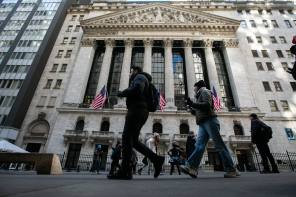
Article 2 / 5
Spring Investment Monitor 2017ETFs continue to buck equity trend

In a year of unexpected events equity markets performed better than some might have expected, with the FTSE All-Share index ending the year up 16.8 per cent in 2016, while the S&P 500 gained 32.7 per cent in sterling terms, data from FE shows.
But in spite of this, retail investors appeared to shun the equity space, with the Investment Association recording net retail outflows from equity funds of £8.2bn in 2016. However, research from Thomson Reuters Lipper shows that while across Europe active equity funds suffered outflows, their exchange-traded fund (ETF) counterparts recorded net inflows suggesting a move towards a more passive approach for equity exposure.
Detlef Glow, head of Emea research at Thomson Reuters Lipper, notes many of the differences in flows between active funds and ETFs can be explained as asset allocation calls for sectors or countries that are seen as less efficient. But in the Lipper US and UK equity sectors there could be an alternative explanation for the relatively high net outflows from active funds and net inflows into ETFs.
“I assume European investors reduced strategic exposure in actively managed products to the two markets prior to the Brexit vote and the [US] presidential election and bought back into the markets to take profits from a tactical move. This would mean investors did not necessarily prefer ETFs by default. Rather, they made a tactical asset allocation decision,” he says.
Data from Morningstar on European domiciled ETFs and open-ended funds shows that in 2016 indexed equity ETF net flows reached an estimated €13.1bn (£11.3bn), while active equity fund net outflows reached €86bn.
Perhaps more understandably a similar trend occurred in the commodities and convertibles sector, where ETFs are a tool for accessing a niche asset class.
Amanda Rebello, Deutsche Asset Management’s head of ETF distribution, UK and Ireland, notes ETFs are estimated to represent roughly 4 per cent of the mutual fund market in Europe but this keeps growing.
In 2016 she suggests many investors were taking positions based on big macro-level views, such as the effect of Brexit or the US election. “These types of big paradigm shifts often lead to views being expressed on an entire market or market segment. When entire markets are moving in this way it can favour index trackers as the tool for positioning rather than looking to individual stock picking,” she explains.
With such significant volatility in 2016 Ms Rebello points out ETFs proved a useful trading tool, given the ease of using them to go into the markets intraday. The liquidity of several ETFs worked as intended, even during stressed market conditions.
But Fannie Wurtz, managing director at Amundi ETF, argues that it is not just market upsets that are driving flows, suggesting: “In truth the enthusiastic take-up of ETFs over the last 10 years is down to structural reasons: costs, transparency and diversification.”
She adds: “Passive solutions like ETFs are not in competition with active ones: on the contrary, active managers are using ETFs more and more in their allocation strategies, as they represent cost efficient solutions to gain exposure to an entire market.”
Meanwhile fixed income net flows into active open-ended funds reached €70.2bn, according to Morningstar, and while passive fixed income ETF flows did not overtake their open-ended counterparts, the €20bn of inflows during the year highlights the rising interest in the sector.
Hortense Bioy, European director of passive fund research at Morningstar, suggests fixed income is “kind of a new story”, with the uptake of these products possibly delayed by the understanding of the structure of fixed income ETFs and investor preference for single bonds or open-ended funds. But she notes this is changing.
“Last year we had more adoptions of fixed income ETFs. Fixed income represents almost a quarter of the market share. It was only 16 per cent in 2011 and now it is 24 per cent,” she says.
In terms of the drivers of ETF flows, Ms Bioy points out cost is the main factor, while flexibility and innovation in the asset classes and range of products is also key. Regulation is also an issue given the advent of Mifid II.
Ms Wurtz adds: “The upcoming Mifid II [regulations] will boost demand [from retail investors], as it will help improve transparency on costs and provide enhanced advisory services to clients. The strong demand for passive solutions is not a blip or a one-off phenomenon but a real, long-term trend, driven by sustained investor appetite and the flexibility these solutions are able to provide.”
Nyree Stewart is features editor of Investment Adviser
Europe-based open-ended funds and ETF flows
| Investment type | Estimated net flows, 2016 (€m) | Total net assets (€bn) | |
| Alternative | |||
| Index | ETF | 2,177 | 10.1 |
| Index | Open-ended fund | -75 | 0.3 |
| Non-index/active | Open-ended fund | 38,914 | 408 |
| Commodities | |||
| Index | ETF | 12,263 | 43.1 |
| Index | Open-ended fund | -72 | 2.6 |
| Non-index/active | Open-ended fund | 1,690 | 14.3 |
| Convertibles | |||
| Index | ETF | 58 | 0.5 |
| Non-index/active | Open-ended fund | -9,752 | 63.3 |
| Equity | |||
| Index | ETF | 13,105 | 356 |
| Index | Open-ended fund | 14,134 | 418 |
| Non-index/active | ETF | 62 | 0.4 |
| Non-index/active | Open-ended fund | -86,021 | 2,360 |
| Fixed income | |||
| Index | ETF | 19,957 | 127 |
| Index | Open-ended fund | 15,544 | 141 |
| Non-index/active | Open-ended fund | 70,176 | 2,057 |
Source: © 2017 Morningstar, Inc. Data as at February 16 2017. |



